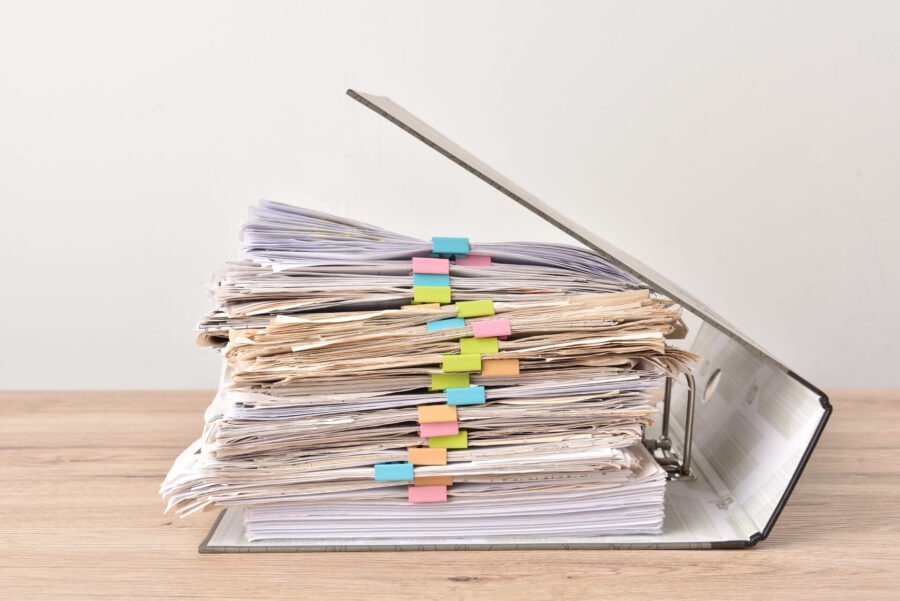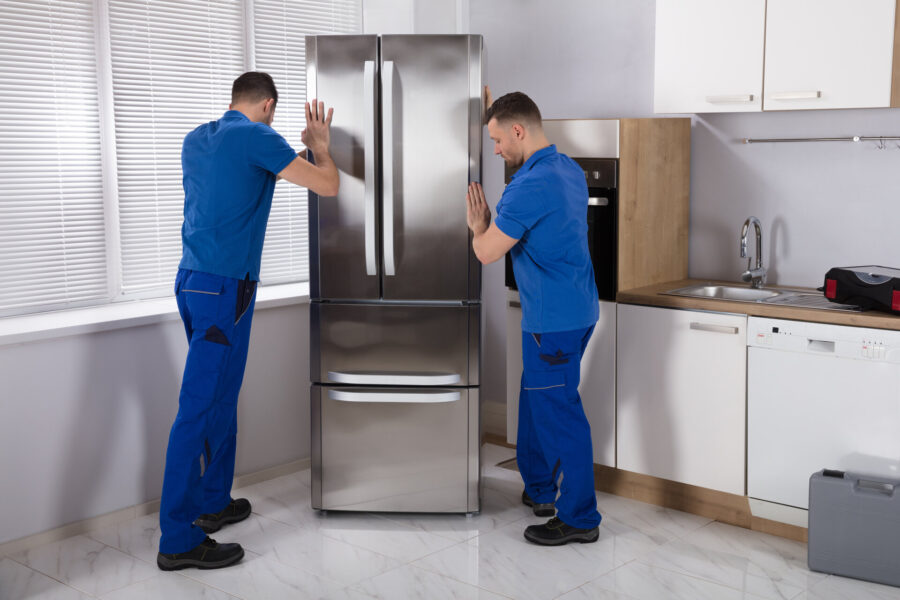Embarking on a relocation journey? Streamline the chaos and keep your sanity intact with our help! Here’s a comprehensive guide on how to create your own moving binder full of resources, brimming with checklists, tips, and tools to ensure a seamless transition. Whenever you’re relocating, let this be your compass through the whirlwind of relocation.

Having a moving binder organizer by your side during preparations for a move to a new state simplifies the entire process. The first step is choosing a binder and dividers and creating sections for all of the aspects of the relocation. Once you label and organize everything, you can proceed to add important documents. Next up, add all of your new apartment checklists and to-do lists, and don’t forget your moving inventory. Lastly, include your relocation budget and crucial contact information.
What Are the Benefits of a Moving Binder?
This concept is more than just a collection of documents – it’s a powerful organizational tool that simplifies the relocation process, keeps crucial information at your fingertips, and ultimately contributes to a less stressful and more successful relocation experience. Investing time in creating a well-structured binder is an excellent relocation hack, an investment in peace of mind, and an efficient move.
Centralized Organization and Easy Access to Important Documents
One of the prime benefits of relocating with a binder is the centralized organization it provides. By keeping all relevant documents, receipts, and contact information in one place, you ensure easy access when needed.
From your cross-country movers’ contact details to rental or purchase agreements, utility setup confirmations, and inventory lists, having everything in a singular location eliminates the chances of misplacing crucial documents amidst all the hustle. One might even say that having a binder is a relocation essential!
Simplifying the Moving Process With a Step-By-Step Guide
Relocating to a new state can be a complex process with countless tasks that need to be managed simultaneously. A binder can serve as a step-by-step guide, helping you tackle each phase of the relocation methodically. By breaking down the process into smaller, more manageable tasks and having a timeline for each, it can serve as a roadmap, ensuring that nothing is overlooked.
Peace of Mind and Reduced Stress During the Move
Relocating is often ranked among the most stressful life events. By bringing structure and organization to the process, binders can significantly reduce this stress. Knowing that you have a plan to relocate to another city in place and that all your important documents and information are secure and easily accessible brings peace of mind. This enables you to focus on the other aspects of the relocation, such as saying goodbyes at a going-away party and getting mentally prepared for the new chapter in a new city.

How to Set Up Your Moving Binder?
Setting up binders requires some upfront effort, but it’s an investment that pays dividends in terms of organization and ease during the process. By choosing the right materials, thoughtfully creating sections, and organizing for easy navigation, you’ll have a powerful tool that keeps you on top of your relocation and helps you avoid common relocation mistakes.
Choosing the Right Binder and Dividers for Your Needs
Start by selecting a binder that’s sturdy and spacious enough to accommodate all the documents and information you’ll be organizing. Opt for the one with pockets for storing receipts or smaller notes. Equally important are dividers – choose tabbed dividers that allow for easy labeling and segmentation of the content. Having a set of sheet protectors can also be useful for keeping important documents safe.
Creating Sections for Different Aspects of the Relocation
Divide the binder into sections that correspond to different aspects of your relocation. Common sections might include the following:
- Relocation company details – Include quotes, contracts, and contact information.
- Inventory lists – Catalog your belongings, especially high-value items.
- Financial documentation – Keep track of budgets, expenses, and receipts.
- Utilities and services – Information on setting up and transferring utilities.
- Personal documents – Medical records, school records, and others.
- Calendar and to-dos – A timeline, checklists, or calendar for relocation-related tasks.
Labeling and Organizing for Easy Navigation
Once you have your sections defined, label the dividers clearly. Using bold lettering or color coding can make navigation even simpler. Within each section, organize the documents in a logical order – for example, you might want to arrange financial records chronologically and inventory lists by room. Make use of sticky notes and highlighters to mark pages or information that you’ll need to refer to frequently.

What Are Essential Documents You Should Include?
A binder serves as a centralized hub for all critical information and documents. Including the right documents ensures a seamless relocation process. Here are some essential documents you should include.
Estimates and Contracts With Movers
One of the first sections should be dedicated to the details regarding your chosen relocation company. Include written estimates you received during your selection process, as these can be handy for reference. Most importantly, keep the finalized contract with the company in this section.
It should contain crucial details such as costs, relocation dates, and terms of service from the hired movers. Additionally, include contact information for the company and any correspondence you’ve had with them.
Storage Services
Looking for storage space while you get settled? California-Seattle Express provides 30 days free storage with your move.
Car Shipping Services
We can ship your vehicles using the best freight options available. Your car will be moved safely and securely and arrive as planned.
Packing Services
Our professional packers have methods and techniques to ensure all your items are intact during and after the move.
Lease Agreements or Real Estate Documents
If you’re relocating into an apartment or house that’s a rental property, your lease agreement is an essential document. It will include the terms of the lease, monthly rent, and landlord contact information.
If you’re purchasing a property, include all real estate documents, such as the purchase agreement, closing documents, and mortgage details. Keeping these ensures that you have all the necessary paperwork at hand should any issue or question arise regarding your new residence.
Inventory Lists, Receipts, and Insurance Information
Inventory lists are indispensable for keeping track of your belongings during transport. Create detailed lists categorizing items by room or type, and note any high-value items. Coupled with this, include receipts for any new purchases made specifically for the relocation, as well as those for high-value items, as they might be needed for insurance purposes. In this section, keep a copy of your relocation insurance policy, along with the coverage details and contact information for claims.

Moving Checklists and To-Do Lists Should Be a Part of a Binder
Incorporating checklists and to-do lists is crucial for managing the plethora of tasks involved in relocating. These lists act as a roadmap, guiding you through each phase of the move.
Preparing a comprehensive timeline
Draft a detailed timeline that outlines the entire process. This timeline should encompass the initial planning stages to the final settling-in at your new city. Including milestones like hiring movers, packing start date, and utility setup will help you visually track progress and stay on schedule.
Breakdown of tasks by weeks or days leading up to the move
Create segmented lists that break down tasks into weeks or days. For example, eight weeks out might include researching relocation companies, while two weeks out might focus on confirming dates and times. This approach ensures that responsibilities are spread out, making them more manageable and reducing last-minute relocation stress.
Packing, address change, and utility shut-off checklists
Packing checklists are vital for tracking what needs to be packed and ensuring nothing is forgotten. Create checklists for different rooms or categories. Moreover, include an address change checklist that reminds you of all the places you need to update your address, such as the post office, bank, and subscriptions. Lastly, having a utility checklist will aid in remembering to shut off services at your old home and set them up in your new one.
Inventory Should Also Be Included
When it comes to relocation day preparations, creating an inventory of your belongings is paramount. Not only does this practice help in organizing the packing process, but it is also invaluable for insurance purposes and ensures that nothing gets lost in the shuffle.
Creating a Detailed Inventory of Belongings
Begin by listing every item to keep and relocate with you. It’s wise to create this list as you go through the packing process. For each item, make a note of any identifying features, and if possible, include a photograph. This will be especially helpful for high-value or sentimental items.
An inventory is not just a list but a record that can be vital if something is damaged or lost during the move. You can opt to make your inventory manually with pen and paper or use a spreadsheet or specialized relocation app.
Categorizing Items and Noting Their Condition
As you build your inventory, categorize items based on the room they belong to or their type (e.g., packed furniture, electronics, kitchenware). This categorization makes unpacking and organizing your new home easier. In addition, categorization is helpful in deciding which items should be packed together.
Additionally, it’s crucial to note the condition of items, especially those that are fragile or valuable. Make a note of any pre-existing scratches, dents, or marks. For electronics, it’s wise to note the model and serial numbers. This thorough record-keeping is indispensable in case you need to file an insurance claim for any damaged goods.

Crunch Some Numbers – Create Budget and Expense Tracker
Relocating often involves numerous expenses, some expected and others that can catch you by surprise. Keeping a handle on your finances during this time is crucial. Creating a budget and an expense tracker can be immensely helpful.
Tracking Expenses Related to the Move
Make a list of all the potential expenses you’ll incur during the move. This should include relocation company fees, packing materials, temporary storage costs, and any travel expenses if you’re moving a significant distance. Actively track these expenses as they arise to avoid unexpected financial stress.
Budgeting for Each Aspect of the Move
Allocate a specific budget for the various aspects of your move. For instance, set aside an amount for packing materials, another for movers’ fees, and perhaps a contingency fund for unexpected costs. This budgeting helps you make informed decisions and prioritize spending based on what’s most important.
Keeping Receipts and Invoices Organized
As you make purchases or pay for services, be diligent in keeping all receipts and invoices. Store them in a designated section. These can be invaluable for accounting purposes, and in some cases, relocation expenses can be tax-deductible.

Create Your Own Binder and Have a Successful Relocation With California-Seattle Express
Combining the power of a well-organized binder with the expertise of a professional long-distance moving company like California-Seattle Express can significantly simplify your relocation process. This puts you in control, helping you manage tasks, budgets, and inventory efficiently.
On the other hand, California-Seattle Express, a reputable cross-country moving company, specializes in long-distance moves between California and Seattle. Our team of professional long-distance movers in California and Seattle are dedicated to making your move seamless and stress-free. From packing services to safe transportation, we handle every aspect of your move with care and precision.
By merging your diligent preparation with the exceptional long-distance moving services of California-Seattle Express, you create a dynamic duo tailored for success. Your binder keeps you on track while our movers Seattle-California provide the expertise and handle the logistics. Together, they alleviate the common stresses of relocating. Embrace the synergy of organization and professional support for an exemplary relocation experience – contact us and hire our exceptional movers from Seattle to California and vice versa.
FAQs
What Should I Include in My Essential Documents Section?
When preparing an important documents section, include identification papers, financial documents, medical records, and housing documents. Identification papers should encompass driver’s licenses, passports, and Social Security cards.
Financial documents could include bank statements, tax records, and loan information. Medical records and prescriptions are important to ensure continuity in healthcare. Housing documents like leases, contracts, and utility information are necessary for a smooth transition.
How Can I Stay Organized With a Moving Timeline in My Binder?
To stay organized with a timeline, create a detailed checklist with deadlines. Start with a broad timeline and break it down into weekly or even daily tasks as the relocation date approaches. Keep an updated calendar and ensure that you review and adjust it regularly. Place all appointments, reminders, and deadlines on this calendar. Remember to allocate time for unforeseen delays.
Is It Necessary to Keep a Detailed Inventory of My Belongings?
Maintaining a detailed inventory of your belongings is essential for various reasons. It helps with organizing, packing, and unpacking, ensuring that nothing is forgotten or lost. It is particularly vital for insurance purposes in case items are damaged or lost during transport.
How Can a Moving Budget Tracker Help With Expenses?
A budget tracker can be invaluable in managing expenses. By listing anticipated costs, such as different packing materials, movers, and travel expenses, you can allocate funds accordingly and avoid unexpected financial strain. This can also help in identifying areas where you can save money.
Can I Use Digital Tools or Apps Instead of a Physical Binder?
Digital tools and apps are viable alternatives. Many apps are available that help with organizing, inventorying, and budget tracking. They have the added advantage of being easily accessible and often offer integration with other services.





